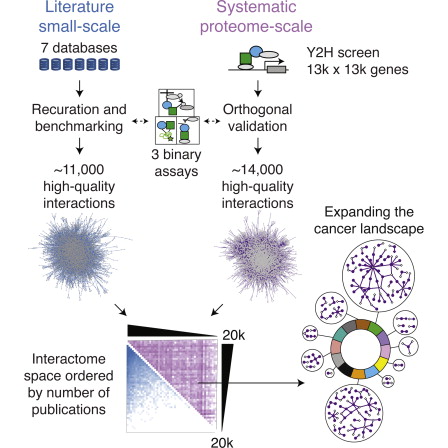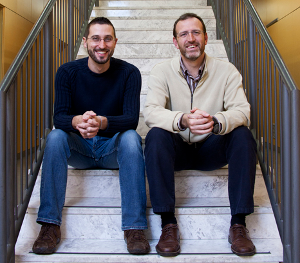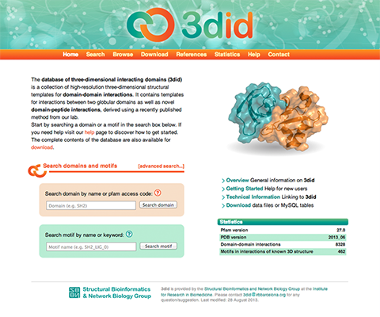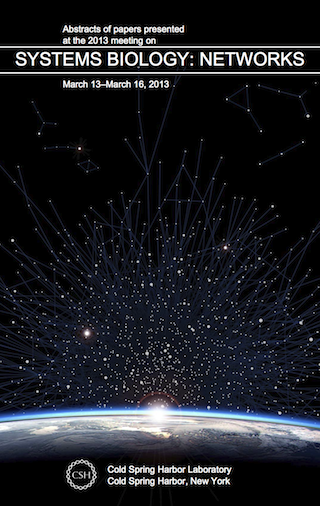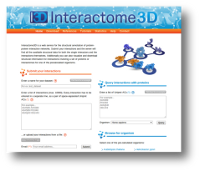News and events
Previous events
|
26 February 2015
dSysMap (which stands for “Disease-mutations Systemic Mapping”) is a computational tool to interpret the effect of genetic mutations on the development of complex diseases by mapping them to the human structural interactome. dSysMap allows to display mutations in the systemic context of the human interactome and to identify their potential "edgetic" effects. |
|
21 November 2014
Scientists have created the largest-scale map to date of direct interactions between proteins encoded by the human genome and newly predicted dozens of genes to be involved in cancer. The new "human interactome" map describes about 14,000 direct interactions between proteins. The interactome is the network formed by proteins and other cellular components that 'stick together.' The new map is over four times larger than any previous map of its kind, containing more high-quality interactions than have come from all previous studies put together. |
|
17 October 2014
Scientists at the Institute for Research in Biomedicine have been participated in a video to raise awareness and support for research into diseases such as #cancer and #metastasis, #Alzheimer’s and #diabetes. For each YouTube viewing of this video our sponsors will make a donation to IRB Barcelona research. Text IRBBARCELONA to 28014 to contribute €1.20 (Spain only*). Direct donations via http://www.irbbarcelona.org/donate Please watch and share. Together we can find the cures. |
|
25 February 2014
Researchers at the J. Craig Venter Institute and the Virginia Commonwealth University in the United States, in close collaboration with scientists at the Institute for Research in Biomedicine (Patrick Aloy, Roberto Mosca and Arnaud Ceol from IRB Barcelona), have published the first map of the molecular interaction of proteins—called the interactome—of Escherichia coli (E. coli). |
|
14 January 2014
The project seeks to identify new biomarkers for Alzheimer’s disease through the “SysPharmAD” project, awarded 1.3 million euros by the European Research Council through a Consolidator Grant. Over the next five years, until 2019, this project aims to monitor the onset and progression of Alzheimer’s disease from its most early stages and to discover new therapeutic targets and chemical compounds able to alter the biology of the disease. |
|
1 January 2014
The database of three-dimensional interacting domains (3did, http://3did.irbbarcelona.org) has been updated with a completely new interface that is more intuitive and easier to query and browse. Check it out at http://3did.irbbarcelona.org and read the publication in Nucleic Acids Research. |
|
7 May 2013, TV3
Our appearance on TV3 about the work on the Analysis of chemical and biological features yields mechanistic insights into drug side effects. |
|
13-16 March 2013, Cold Spring Harbor, NY 11724-2213
We are pleased to announce the third Cold Spring Harbor Laboratory meeting on Systems Biology: Networks. This meeting alternates with the established CSHL meeting on Systems Biology: Global Regulation of Gene Expression, thus providing complementary forums for discussion of major themes in systems biology. Keynote Speakers: |
|
16 December 2012
Our new Interactome3D server for the structural annotation of protein-protein interaction networks is now online. Check out the server at http://interactome3d.irbbarcelona.org and the publication on Nature Methods. |
|
19 April 2012
The video abstract for our article in BioEssays : Towards Alzheimer's root cause: ECSIT as an integrating hub between oxidative stress, inflammation and mitochondrial dysfunction is available at the Wiley-Blackwell Life Sciences Youtube channel (http://www.youtube.com/user/WBLifeSciences). |
|
21-23 November 2011, Barcelona, Spain
As mathematical systems theory praises, the scale and complexity of the solution should match the scale and complexity of the problem, and biology is no exception. In the recent years it has become apparent that many common disorders such as cancer or cardiovascular and mental diseases are much more complex than initially anticipated since they are often caused by multiple molecular abnormalities, rather than the result of a single defect. |
|
18 November 2011
The poster presentation of Miquel Duran was awarded the 1st poster prize on the "2nd IRB Barcelona PhD Student Symposium - Life in motion" (Barcelona, 2011) out of a total of 75 posters. Miquel Duran is a PhD student in the SB&NB group. He presented his work "Understanding and predicting adverse drug reactions from chemical and biological spaces", where he explores the concept of using side effects of drugs as phenotypic signals of drug action. |
|
17-18 November 2011, L'Aquàrium. Barcelona, Spain.
“Life in motion: dynamics of molecules and systems” is a scientific and educational meeting |
|
15 May 2011
The Structural Bioinformatics and Network Biology group is happy to present its new web-site. |


